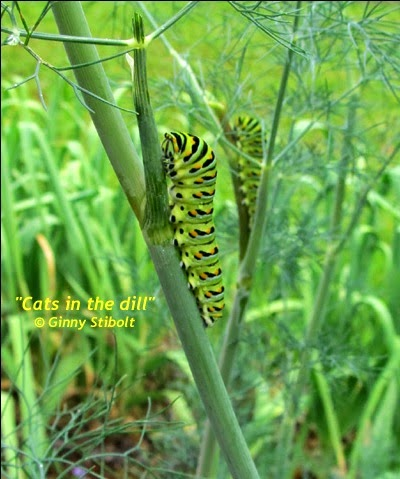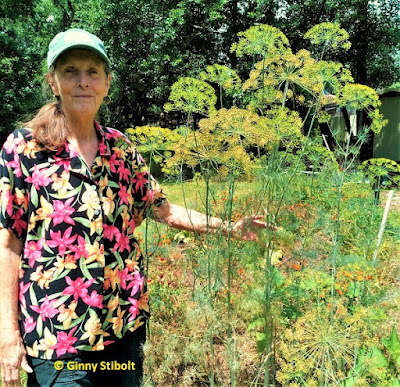 |
| Pollinators love dill flowers. |
Dill (Anethum graveolens) is a fast-growing, cool-weather annual with a long taproot. It provides both a classic herb and a spice--the leaves are called dill weed, and used fresh or dried as a herb in salads or as a garnish, while the seeds are used as a spice for pickling or in potato and pasta salads. Dill is native to the Mediterranean region, but it's grown world wide.
The majestic dill flower heads can reach fourteen inches across. They attract a wide variety of pollinators, and importantly for organic gardeners, dill attracts the small parasitoid wasps that prey on tomato worms and other garden pests.
All the above-ground parts of the dill plant are edible. The leaves and the seeds are most often harvested, but you can also eat the flowers and the stems.
Taxonomic note: The Kew Garden's Plants of the World Online database considers dill (Anethum graveolens) and several other related species to be synonyms of false fennel (Ridolfia segetum). I have not found other organizations joining in on this lumping of species as yet, but there may be a dill name change in the future.
The carrot family (Apiaceae)
This family includes 446 genera and in addition to dill, there are many are economically important plants as angelica, anise, caraway, carrot, celery, chervil, coriander, cumin, fennel, lovage, parsley, and parsnip. The family also includes some poisonous species, including poison hemlock, water hemlock, spotted cowbane, fool's parsley, and various species of water dropwort.
The defining characteristic of this family is the inflorescence, where the flowers are aggregated in terminal umbels, which may be simple or more commonly compound such as dill. The other name for this botanic family is Umbelliferae.
Managing dill in Florida gardens
The planting and growing advice that we provided in "Organic Methods for Vegetable Gardening in Florida" is:
"Planting: Plant the seeds directly in the garden every few weeks starting in the fall. Gardeners in colder areas in the northernmost part of the state may lose some of their dill to the cold, but dill will last through most Florida winters. Dill has a long taproot, so it doesn't transplant well after the seedling stage." Note: I ignore this advice, because my dill self seeds in our vegetable beds. It's been years since I've purchased dill seeds. Some years I have transplanted the seedlings into rows away from the other cool-weather crops, but mostly I let them grow where they want.
"Growing: Full sun or slight shade; more shade in South Florida. Once the hot weather hits, dill bolts quickly. Some growers blanch the lower stems by mounding soil around them. The white stems are said to be milder, and are sometimes used in Asian cooking."
"Maintaining: The long taproot makes dill somewhat drought tolerant after the seedling stage. Cutting back the stems will postpone the flowering, but do allow some to flower in order to attract the beneficial insects. Once you have allowed the dill to go to seed, it's likely to show up randomly in next year's garden. Learn to recognize its seedling stage so you can quickly move volunteers to appropriate beds."
 |
| Collecting dill seed in a bag. |
"Harvesting: Cut leaves as needed. They can be dried, but they are definitely better fresh. To harvest the seeds, wait until they turn brown, place the whole flower head in a bag, and then shake the seeds loose."
"Using: Use the leaves uncooked as a garnish or in salads and dressings. If you cook dill, add it late in the cooking process, as it will lose flavor; it is good in soups and stir-fries. The seeds can be used not only in pickling, but also in potato or pasta salads. The dill stems can be sliced thinly and used in stir-fries or soups."
 |
| Black swallowtail cats in the dill. |
Why do the native black swallowtail butterflies lay their eggs on my exotic dill and parsley?
This butterfly species (Papilio polyxenes asterius) always lays its eggs on members of the carrot family (Apiaceae) and there are any number of natives that they could use to feed their cats, such as water hemlock, cowbane, or blacksnakeroot. But maybe my dill just tastes better than those mostly poisonous relatives. Perhaps our native plants are smarter than dill and produce chemicals that moderate herbivore activity. After all, dill has been bred to taste good to the human palate.
For more information and photos of all stages of this butterfly, read this UF profile of the Black Swallowtail Butterfly (Papilio polyxenes asterius). (Note: some people mistake this caterpillar for the monarch butterfly, but if it's on a carrot family plant, it's not a monarch.)
So, I hope that if you haven't grown dill before that you add some of this easy-to-grow crop to your home-grown vegetable and herb collection. It will make your food dill-icious!
Green Gardening Matters,
Ginny Stibolt


No comments:
Post a Comment